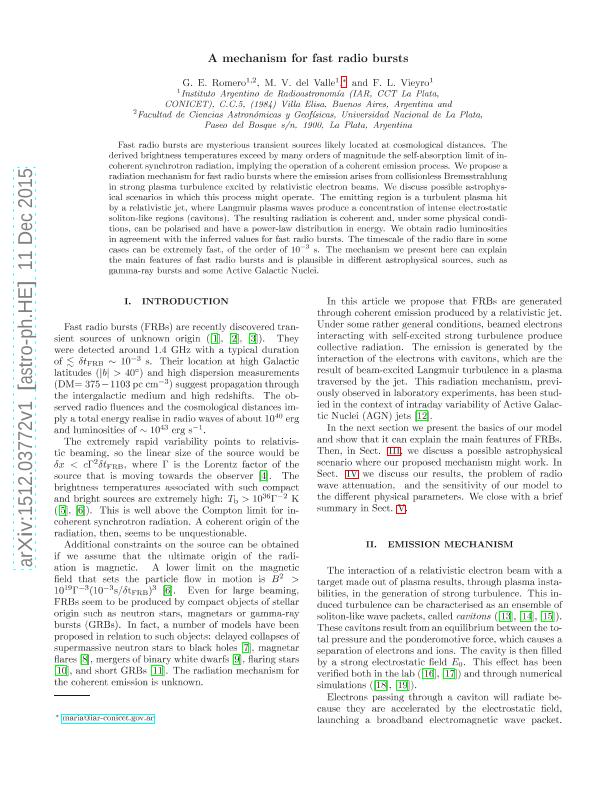Mostrar el registro sencillo del ítem
dc.contributor.author
Romero, Gustavo Esteban

dc.contributor.author
del Valle, Maria Victoria

dc.contributor.author
Vieyro, Florencia Laura

dc.date.available
2020-08-07T17:23:21Z
dc.date.issued
2016-01
dc.identifier.citation
Romero, Gustavo Esteban; del Valle, Maria Victoria; Vieyro, Florencia Laura; Mechanism for fast radio bursts; American Physical Society; Physical Review D; D93; 1-2016; 023001-023007
dc.identifier.issn
0556-2821
dc.identifier.uri
http://hdl.handle.net/11336/111186
dc.description.abstract
Fast radio bursts are mysterious transient sources likely located at cosmological distances. The derived brightness temperatures exceed by many orders of magnitude the self-absorption limit of incoherent synchrotron radiation, implying the operation of a coherent emission process. We propose a radiation mechanism for fast radio bursts where the emission arises from collisionless Bremsstrahlung in strong plasma turbulence excited by relativistic electron beams. We discuss possible astrophysical scenarios in which this process might operate. The emitting region is a turbulent plasma hit by a relativistic jet, where Langmuir plasma waves produce a concentration of intense electrostatic soliton-like regions (cavitons). The resulting radiation is coherent and, under some physical conditions, can be polarised and have a power-law distribution in energy. We obtain radio luminosities in agreement with the inferred values for fast radio bursts. The timescale of the radio flare in some cases can be extremely fast, of the order of 10−3 s. The mechanism we present here can explain the main features of fast radio bursts and is plausible in different astrophysical sources, such as gamma-ray bursts and some Active Galactic Nuclei.
dc.format
application/pdf
dc.language.iso
eng
dc.publisher
American Physical Society

dc.rights
info:eu-repo/semantics/openAccess
dc.rights.uri
https://creativecommons.org/licenses/by-nc-sa/2.5/ar/
dc.subject
Radiation mechanisms
dc.subject
Radio continuum
dc.subject.classification
Astronomía

dc.subject.classification
Ciencias Físicas

dc.subject.classification
CIENCIAS NATURALES Y EXACTAS

dc.title
Mechanism for fast radio bursts
dc.type
info:eu-repo/semantics/article
dc.type
info:ar-repo/semantics/artículo
dc.type
info:eu-repo/semantics/publishedVersion
dc.date.updated
2020-08-04T19:35:56Z
dc.journal.volume
D93
dc.journal.pagination
023001-023007
dc.journal.pais
Estados Unidos

dc.description.fil
Fil: Romero, Gustavo Esteban. Universidad Nacional de La Plata; Argentina. Provincia de Buenos Aires. Gobernación. Comisión de Investigaciones Científicas. Instituto Argentino de Radioastronomía. Consejo Nacional de Investigaciones Científicas y Técnicas. Centro Científico Tecnológico Conicet - La Plata. Instituto Argentino de Radioastronomía; Argentina
dc.description.fil
Fil: del Valle, Maria Victoria. Provincia de Buenos Aires. Gobernación. Comisión de Investigaciones Científicas. Instituto Argentino de Radioastronomía. Consejo Nacional de Investigaciones Científicas y Técnicas. Centro Científico Tecnológico Conicet - La Plata. Instituto Argentino de Radioastronomía; Argentina
dc.description.fil
Fil: Vieyro, Florencia Laura. Provincia de Buenos Aires. Gobernación. Comisión de Investigaciones Científicas. Instituto Argentino de Radioastronomía. Consejo Nacional de Investigaciones Científicas y Técnicas. Centro Científico Tecnológico Conicet - La Plata. Instituto Argentino de Radioastronomía; Argentina
dc.journal.title
Physical Review D

dc.relation.alternativeid
info:eu-repo/semantics/altIdentifier/url/http://journals.aps.org/prd/abstract/10.1103/PhysRevD.93.023001
dc.relation.alternativeid
info:eu-repo/semantics/altIdentifier/doi/http://dx.doi.org/10.1103/PhysRevD.93.023001
Archivos asociados
